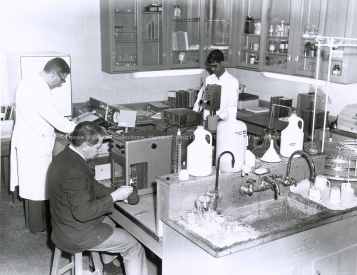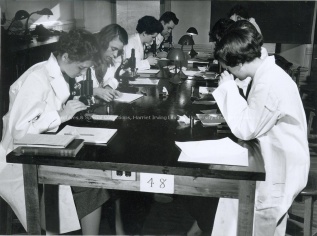Department of Biology
Previously named: Chemistry and Natural Science, Natural Science, Biology and Zoology
Established: 1941
History: Biology courses have been offered regularly at the University of New Brunswick since the late 1830s. In 1837, James Robb, a Scottish scientist, was appointed as Professor of Chemistry and Natural Science at the King's College. Along with the study of Natural Sciences (Biology), courses in Chemistry and Geology were major components of this curriculum throughout the late nineteenth and early twentieth centuries.
In 1861, Loring Woart Bailey, a geologist and trained chemist, replaced Robb and held the Chair of Chemistry and Natural Science position until 1907. Botany, Zoology, and Geology were taught in the late 1800s and early 1900s, under the 'Chemistry and Natural Science' discipline. Course offerings throughout these years included Molecular Physics, Organic and Inorganic Chemistry, Zoology, Human Anatomy, Vegetable and Animal Physiology, and Geology. Experimental Chemistry was offered to first and second-year students beginning in the 1890s. The Bachelor of Science program was also established in 1890. Following Chemistry’s separation from Natural Science in 1900, the curriculum then turned its focus to courses in Botany, Animal Biology, Human Physiology, and Physical Geography and Geology. Honours courses began in an undergraduate student’s third year and consisted of Zoology and Astronomy, Mineralogy, followed by Lithology in a student's fourth year.
L.W. Bailey's retirement in 1907 coincided with significant advancements in the university's curriculum and the science departments as a whole. The creation of the Department of Applied Science in 1909, under the faculty of the same name, introduced a more in-depth study of the scientific and engineering disciplines, previously offered under the Faculty of Arts and Sciences. For the time being, Biology course offerings were kept to a minimum in this department, with the exception of particular botany courses required for obtaining a Bachelor of Science degree in Forestry. Biology courses remained listed under the Faculty of Arts and Science until the 1940s. By 1930, the department of ‘Chemistry and Natural Science’ was divided into the Departments of Biology, Chemistry, and Geology, although the year of their official departmentalization is acknowledged as 1941. The Department of Biology prioritized courses in zoology and animal and plant biology during this period.
Throughout the 1940s and early 1950s there was an influx of ex-service students at UNB. It eventually resulted in sufficient staffing within the department, enough to manage the drastic increase in undergraduate enrollment. The Faculty of Arts and Science was divided in the early 1950s, allowing the Department of Biology to fall under the Faculty of Science. Some course offerings during this period included Elementary General Biology, Elementary Botany, Vertebrate Zoology, Systematic Botany, Plant Anatomy, Genetics, Plant Pathology, Bacteriology, and Biochemistry. In the late 1940s, there were thirteen Biology courses, which then grew to eighteen by 1955. Growth was slow but continued steadily, and by 1972, there were around nineteen staff members in the department and twenty-six Biology course offerings at the undergraduate level. At the end of 1976 school year, the department had a staff of thirty-eight instructors.
The early 1980s saw Biology course offerings increase at sixty-six, with new additions such as Introductory Virology, Population Genetics, Microbial Physiology, Diseases of Forest Trees, Ecosystem Dynamics, and Biochemical Methods. For students majoring in Biology, there were eight different programs available by the mid-1980s. These programs were the Aquaculture and Fisheries Biology Program, the Biomedical Program, the Botany-Plant Science Program, the Entomology Program, the General Zoology Program, the Molecular and Microbiology Program, the Parasitology Program, and the Physiology Program. To properly accommodate each program option, the Department continued to grow, adding eighty-five courses by 1986-87. By the mid-2000s, there were more than forty Biology instructors and ninety-two course offerings. In the 2012-2013 year, there was a slight increase with ninety-five courses, some newer additions being Advanced Studies in Ichthyology, Ecology of Marine Birds, and Introduction to the Vascular Plant of New Brunswick.
Physical location: Loring Bailey Hall
Faculty: Science
Notes: The year that a certain department was established can be a subjective figure. For the purpose of this wiki, the year that a department is considered first established is the first year it was listed in the academic calendar as an independent chair with no other affiliation, unless documentation can demonstrate otherwise.
Source(s):
- Toole, F.J. “Chapter VI: The Scientific Tradition”. The University of New Brunswick Memorial Volume. Ed. Alfred G. Bailey. Fredericton: University of New Brunswick, 1950. 69-74.
- Department of Biology fonds (UA RG 330); Administrative history
- UNB Calendars (UA RG 86) 1861-62, 1862-63, 1887-88, 1890-91, 1897-98, 1900, 1909, 1930, 1931, 1932, 1941, 1944-45, 1949-50, 1952-53, 1955-56, 1969-70, 1971-72, 1975-76, 1981-82, 1982-83, 1986-87, 2003-04, 2005-06, 2007-08, 2012-13.
--HollyMiller 5 November 2013 (ADT)
© UNB Archives & Special Collections, 2014

